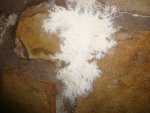- Aug 18, 2010
- 3
Our chlorinated pool just turned one this month. We have a grotto that has large white almost stalactite looking crystals growing on the roof and sides. The grotto is made up of Moss rock. I have always just assumed that it is calcium. I know NOTHING about chemistry but between my husband and I we have kept all the levels correct and compensated immediately when a level started showing signs of straying from the norm. I am amazed at how large these 'crystal' looking spots have gotten in just one year.
My 11 yr old daughter is starting on the science magnet program next week at intermediate school. This school has a lot of very sophisticated science students because our district is the NASA district and parents put a lot into their children's education. My daughter has been looking for science fair projects for 3 months now and keeps running into the 'real world application' problem of any idea she presents.
Chemists/Mineral geeks out there, if you are willing, please tell us how to test for what those deposits are. My daughter was thinking about either investigating which conditions are present to cause this excessive crystal formation (if that's what it is) OR which would be the most environmentally friendly method of cleaning the desposits. We have left the deposits growing, untouched, mostly due to fascination from the kids, so we have a prime experimental ground.
Any help, ideas, would be much appreciated. Please bear in my that I am a software engineer and my husband is an instrument technician.. our combined chemistry knowledge is probably equivalent to first year college :-(
Thanks! I will take pictures tomorrow and post...I personally think the deposits are spectacular despite the fact that they look like bird poop from a distance.
My 11 yr old daughter is starting on the science magnet program next week at intermediate school. This school has a lot of very sophisticated science students because our district is the NASA district and parents put a lot into their children's education. My daughter has been looking for science fair projects for 3 months now and keeps running into the 'real world application' problem of any idea she presents.
Chemists/Mineral geeks out there, if you are willing, please tell us how to test for what those deposits are. My daughter was thinking about either investigating which conditions are present to cause this excessive crystal formation (if that's what it is) OR which would be the most environmentally friendly method of cleaning the desposits. We have left the deposits growing, untouched, mostly due to fascination from the kids, so we have a prime experimental ground.
Any help, ideas, would be much appreciated. Please bear in my that I am a software engineer and my husband is an instrument technician.. our combined chemistry knowledge is probably equivalent to first year college :-(
Thanks! I will take pictures tomorrow and post...I personally think the deposits are spectacular despite the fact that they look like bird poop from a distance.



